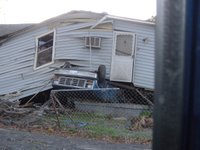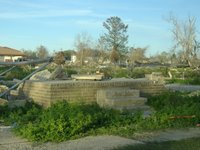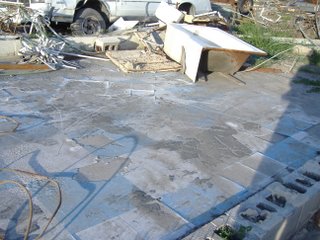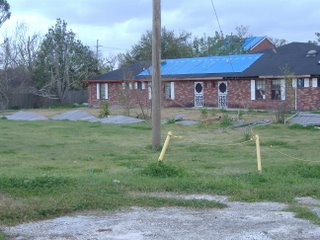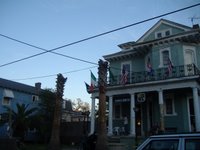
Day 8: Saturday March 18, 2006 – Departure from New Orleans
As I prepare to leave New Orleans and return to Washington, I take a minute to reflect on the dozens of conversations I have had with people affected by Katrina. My cab driver who took me home the other evening from the internet café told me her story about how she lost her home and her new landlord keeps raising the rent. It was originally $600 for a 1BR apt, now it is $900 and it is about to go up to $1500 – which she can’t afford on a cab driver’s salary.
She says that a FEMA official told her that it might be best if she just moved somewhere else because New
 Orleans would no longer be a place for her to live. She thinks she may start living in her cab. I realize as I’m driving through the city with her, that I have only seen a handful of the notorious white FEMA trailers which are supposed to provide housing to the evacuees. We pass a parking lot full of the trailers, unoccupied because of bureaucratic red tape – she groans and asks me if I will help them when I return to Washington. When she dropped me off at the hostel, she waited for me to walk up the street and go inside because she was concerned about the safety in the neighborhood. I’m continually amazed by the kindness and concern people like her exhibit to me.
Orleans would no longer be a place for her to live. She thinks she may start living in her cab. I realize as I’m driving through the city with her, that I have only seen a handful of the notorious white FEMA trailers which are supposed to provide housing to the evacuees. We pass a parking lot full of the trailers, unoccupied because of bureaucratic red tape – she groans and asks me if I will help them when I return to Washington. When she dropped me off at the hostel, she waited for me to walk up the street and go inside because she was concerned about the safety in the neighborhood. I’m continually amazed by the kindness and concern people like her exhibit to me.Even when I’m walking along Bourbon Street, I have the chance to speak to store owners when I buy souvenirs for my family. Several store owners told me that they no longer live in NO, they live in Houston but they return to NO a few days a week to run the store to make any money they can. They are so thankful for my business and ask me to tell my friends to sho
 p there, because they depend on tourists like me. One shows me a beautiful picture of the canal that looks so peaceful on most days, except for that treacherous day in August.
p there, because they depend on tourists like me. One shows me a beautiful picture of the canal that looks so peaceful on most days, except for that treacherous day in August.I have talked to dozens and dozens of people native to New Orleans – waitresses, janitors, security guards, cab drivers, store owners – every singly one has a story to tell – every person I meet has been affected severely by Katrina. It is 7 months after Katrina, and many people still live in dire conditions, hopeless that the government will do anything to save them. I recall some of the t-shirts I see along Bourbon Street: “Make Levees, Not War”, “ReNew Orleans”, “Meet The Fockers: Ray Nagin, Kathleen Blanco, Michael Brown”, “Katrina Struck and all I got was this Cadillac and Plasma TV.” And of course, the everpresent “Re-build New Orleans.” This city is so beautiful, famous for its amazing food, soul, and “all that jazz” – it must be rebuilt, but how? When? By whom?
My plane lands at Dulles and the United Airline flight attendants make an announcement to everyone on the plane thanking all of the volunteers who spent the week in New Orleans working to make things just a little better. Everyone on the plane starts clapping and thanking us. Blushing, I’m deeply humbled by this beautiful gesture and say a small prayer of thanks for taking part in this extraordinary, inspiring, life-changing week.




